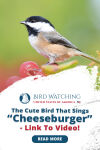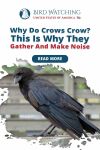
What’s This Post About?
The subtle harmonies and melodic sounds of birdsongs are admired by both birders and non-birders. You do not have to be an enthusiast or an avid bird watcher to enjoy the songs that the birds sing.
Since it is not easy to decipher what the bird is singing, often random words that sound similar to the song are used to differentiate between the different songs.
Most birds are small and easily camouflaged by foliage. They aren’t visible, but their songs and calls can be heard. In this case, it can be beneficial to learn how to recognize the bird songs to identify them.
The cute bird that sings cheeseburger is none other than a black-capped chickadee. The bird’s energy and curiosity make it the cutest bird. The black-capped chickadee sings a lovely song that sounds a lot like it’s saying cheeseburger.

The Bird That Sings Cheeseburger
The black-capped chickadee has earned this name due to its physical appearance and vocals that sound like chick-ka-dee-dee.
The black-capped chickadee is the bird that sings ‘cheeseburger’. What does a bird that cries for a cheeseburger look like though? It looks as cute as it sounds.
It is a small and chubby bird with a tiny beak and tiny feet. The most significant feature is perhaps the blackhead that looks like a black cap hence the name.

It also has a very specific black marking on its throat which looks like a bib. Sort of perfect, since it is calling out for a cheeseburger!
The black cap and the black bib enclose white patches on its cheek. The wings are long, grey, and black, while the lower body is slightly brown with a white undertone.
Some Interesting Facts
As the chickadee ages, its brain makes more space to store additional information by replacing old neurons with new ones.
You are mistaken if you think that the only fascinating thing about a black-capped chickadee is its cheeseburger song. There are numerous other things to learn about that will leave you in absolute awe.
-
The bird has an excellent memory. It is observed that they hide their food for later consumption. This information can be retained for up 28 days.
-
They have a pecking order that is decided based upon the level of aggression of the bird.
-
They are a natural pest control as their diet mainly consists of insects, especially in the summer.
-
They are present all year round and are prepared to handle the cold. They preserve their energy by dropping their temperature by about 10-12 degrees. They allow warm air to get trapped as they keep their feathers away from their body.
Did You Know?
The chickadees will change their mating pairs as the pecking order evolves. This is because the birds keep competing for a better position in the hierarchy.
Why Do Birds Sing Songs?

Birds sing for several reasons, depending on the conditions and the requirement of each specific bird. The following are some of the most prevalent causes for birds to sing:
-
The song alerts other birds to the presence of a healthy, active male on the territory.
-
Attracting a mate by informing the females that he is powerful and capable of defending a decent territory.
-
In certain bird species’ courting traditions, both genders sing a beautiful song that deepens their pair connection.
-
Attract a partner to a food source
-
Recall them to brooding duties
-
Keep birds connected while traveling
Singing, however pleasant it sounds, comes with its own set of troubles. Singing can result in making the birds vulnerable as it attracts predators.
Producing high-pitched sounds continuously also leads to exhaustion and energy consumption.
When Does The Black-Capped Chickadee Sing ‘Cheeseburger’?

The cheeseburger song is sung for two important reasons. First, the birds use this call to indicate their possession of a certain boundary and attract females.
In most cases, it is their aggressive defense of territory that attracts the female.
The female is most attracted by a male that has a loud and clear ‘cheeseburger’ call. This is because this is a sign of strength and valor. They want these characteristics in their children and feel comfortable raising them with a male with these qualities.
The ‘cheeseburger’ is also known as the ‘fee bee’ song. This is because it technically makes a sound that is heard as ‘fee bee,’ but since these words have no remembrance value, the word cheeseburger is assigned for the sake of retention.
The two-toned whistle has a pitch that descends towards the end. It is common, especially during the spring and late winter seasons.
Other Songs And What They Mean
As little as they are, Chickadees indeed have a lot to say!
Chickadee language is one of the most complicated and interesting in the bird species, with a wide range of clever signals that listeners may decipher to gain a better understanding of their surroundings.

There are 6 other calls of a chickadee apart from the one I just discussed.
1. The Chick-ka-dee Call
It is no secret that the ‘chick-ka-dee’ call is the most famous one out of the lot. After all, the bird has been named after it. This sound is easily heard and recognized all year round.
People believe that this call is their song, but it is utilized to aid in coordinating their movement and activities.
This sound is frequently heard when they are:
-
communicating levels of urgency regarding food, activity
-
Alerting for potential hazards hiding nearby.
Alarm vs Non-Alarm situations
This isn’t a new type of call but a subdivision of the first kind.
Since the chickadee call is used to communicate about a new source or as a warning signal, it can lead to confusion. There is, however, a way to identify the exact purpose behind their call.
The next time you hear the famous ‘chick-ka-dee’ call, have an ear out for the number of ‘dees’. The more the number of dees in the call, the more problematic situation the bird is in.
Pro-Tip
4 or more number of dees is considered an alarming situation.

2. The ‘Fee-bee’ song
This is the song more commonly known as the cheeseburger. I have already discussed this above.
3. Companionship Calls
These calls are usually used for normal conversation between the birds. This is why these are way less distinct and not commonly heard of.
Chickadees use these flock calls regularly to stay in contact with the flock while foraging for insects and feed in the forest. It Is a call that continues for a long time unless interrupted by a potential predator.
Pro-Tip
This call is subtle and heard when two or more birds are together.
4. The Gargle Call
The gargle doesn’t sound like a song. It’s tough to put into words what the gargle call sounds like. It sounds like a jumbled-up collection of calls with a faint PING sound tossed in for extra effect.
It’s tied to courting and territorial activity in the flock during the breeding season and throughout the winter seasons. The two familiar places you will hear this call is:
-
When a swarm of chickadees congregates around a busy bird feeder. When males get too close to one other, they create this gargle as a sign of aggression.
-
The gargle is used to indicate nesting season.
Pro-Tip
Pay attention to any unexpected interruptions or silences in their partner calling since this might be a strong indicator that a predator is lurking around the corner.
5. Fledgling Begging Calls
This is a sound that is heard right after the nesting period. It’s the sound the juveniles make. They are still new to the world, and every discovery ends up making them feel vulnerable. They make these calls begging for some sort of support or help.
Pro-Tip
A way to recognize a begging call is to observe if it is followed by a parent bird flying towards the juvenile making the call.
6. Aerial Predator Alarm Call
As the name suggests, this call is a cry for immediate help. These are short bursts of rapid, high-pitched sounds indicating nearby danger.
If you want to help the bird out, you will have to be well versed with all the calls. Otherwise, waiting or counting the number of ‘dees’, for example, will not pan out well for the bird in the actual field.
You have to be alert and listen for calls that you already recognize to make a quick move.

Why Are Bird Songs Named After English Words?
Try to memorize or even recite a phrase in a foreign language that you don’t recognize. It’s also a lot more accessible for a person to utter words in a natural speech than it is to accurately imitate the elevated tones and melodies of a bird’s song. Naming it after different words we understand makes things easier.
Birding is a memory-intensive hobby; thus, cognitive techniques that assist in recalling precise information, particularly when it comes to songs, are helpful to enthusiasts.
The bird’s song is sometimes so distinctive that it is named after it, allowing for immediate recognition and identification.

Why The Black-Capped Chickadee’s Song Is Called Cheeseburger?
Are you wondering why people call the song cheeseburger when that is not what the bird is saying? Don’t worry; the bird did not suddenly get smarter.
These words have less to do with what the bird is singing and more with the closest word it sounds like that people can remember.
As a result, most American birders have devised memorization methods based on English phrases that mirror the rhythm or timbre of a song’s wording.
In this case, ‘cheeseburger’ is made up of a long high note followed by two shorter and lower notes.
Does It Sound Like A ‘Cheeseburger’?
The true tune goes something like this: 'fee bee-bee'.
You will find people arguing how these sounds are similar to the words ‘cheese’ or ‘burger’.
In reality, someone just concluded that the cadence of the term “cheeseburger” corresponds to the above-mentioned high-pitched three-syllable song of the Mountain Chickadee.
Listen to the song carefully in the video above and decide for yourself if you hear the word ‘cheeseburger’. I don’t know if it is because I already have the word set in my mind.
A better way to test if the song sounds like ‘cheeseburger’ would be to have a friend guess it. Someone who does not already know that he is hearing for ‘cheeseburger’ is more likely to make a more sound judgment.

Other Words And Phrases Associated With Bird Songs
Since the purpose is to retain it, you may make up your linguistic system to recall bird songs. Nothing about the selected terms is absolute, and you are free to name songs as they suit you.
However, below is a selection of traditional mnemonic lines and the species with which they are associated.
| Bird | Call |
|---|---|
| Carolina Wren | “Teakettle” |
| Eastern Towhee | “Drink your teeeeeeea!” |
| American Goldfinch | “Potato chip” |
| Tufted Titmouse | “Peter-peter-peter” |
| American Robin | “Cheerily, cheer up, cheer up, cheerily, cheer up” |
| Blue Jay | Jay! Jay! Jay! |
| Northern Cardinal | Wacheer, pretty, pretty, pretty! or Theodore, Theodore |
| Red-bellied Woodpecker | Churrrrrrr! Burrrrr! (rattle) |
| Chestnut-sided Warbler | please, please, please to meet cha! |
| Ovenbird | teacher, teacher, TEACHER! |
These phrases are especially for children who are interested in bird-watching. The silly phrases not only help them remember the tunes but also keeps them entertained.
It’s not a bad suggestion for the adults also.
How To Attract Black Chickadees?

Chickadees are a lively, fascinating addition to any birder’s collection, and thankfully, attracting these eager birds is simple.
The best part about them is that they also attract rare birds like woodpeckers who flock with them because of the chickadees who have an excellent eye for a food source.
The feeder is a great technique to encourage chickadees to visit your yard. You can buy a hopper feeder, a platform feeder, or even a tube feeder.
It Is advised to fill the feeder with sunflower seeds. Explore the Droll Yankees Bird Feeder.
Droll Yankees Bird Feeder
The motorized perch ring is designed to start spinning under the weight of a squirrel to 'flip' the squirrel off the bird feeder
Black-capped Chickadees, like other birds, are drawn to spaces that offer them food, safety, and breeding opportunities.
Chickadees prefer areas with a lot of trees, vegetation, and some open places. You should buy a nesting box if your yard doesn’t already have decaying trees or good nesting places.
Pro-Tip
The nesting box or a birdhouse will be the ideal attraction during the breeding season.
Another addition can be a birdbath. Chickadees will drink and bathe in birdbaths. However, shallow baths are required due to their small size. Running water with a little sound and splashes will lure chickadees.
Pro-Tip
If a water dish is too deep for chickadees to utilize, consider placing a smaller dish within it or spreading river pebbles or sand around the bottom.

You can also build an insect-friendly yard.
You can do this by planting blooming trees or fruit bushes that will attract insects in the backyard to provide them with enough food and use pesticides and insecticides sparingly. This is because chickadees consume insects, seeds, nuts, and fruits.
This is because chickadees consume insects, seeds, nuts, and fruits.
Pro-Tip
For the winter season, you can attract the chickadees by providing shelter and food since that is scarce.
Keep Reading!
Due to its energetic and outgoing demeanor, the Black-capped Chickadee is a famous garden bird. It’s a fantastic bird to have to play and breed in your garden because of its familiar and joyful songs.
One song sounds like the word ‘cheeseburger’ to some but mainly is associated with the sake of remembrance.
This song is especially sung to signal territories and attract female counterparts. There are numerous other calls, each with a distinct purpose. Study how to set up a bird feeder to attract these cute birds and learn more about them!
7 Simple Steps to Help You Setup a Bird Feeder Including Pictures and Pro tips!
Setting up your bird feeding station is an easy process if you follow these 7 steps. Here is a guide that will help you along this way.

By David A. Swanson
Bird Watching USA
My name is David and I'm the the founder of Bird Watching USA! I started Bird Watching with My father-in-law many years ago, and I've become an addict to watching these beautiful creatures. I've learnt so much over about bird watching over the years that I want to share with the world everything I know about them!

David A. Swanson
Bird Watching USA
My name is David and I'm the the founder of Bird Watching USA! I started Bird Watching with My father-in-law many years ago, and I've become an addict to watching these beautiful creatures. I've learnt so much over about bird watching over the years that I want to share with the world everything I know about them!





![Ravens and Crows Size Comparison [23 Cool Pictures] Thumbnail](/assets/resized/img/posts/raven-vs-crow-size-100x150.jpg)


![Ravens and Crows Size Comparison [23 Cool Pictures] Thumbnail](/assets/resized/img/posts/raven-vs-crow-size_thumbnail-100x56.jpg)

